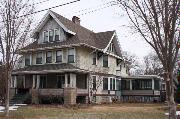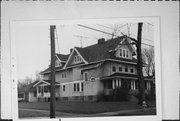Property Record
338 PARK ST
Architecture and History Inventory
| Historic Name: | Frank D. & Edna Lake House |
|---|---|
| Other Name: | |
| Contributing: | |
| Reference Number: | 60881 |
| Location (Address): | 338 PARK ST |
|---|---|
| County: | Winnebago |
| City: | Menasha |
| Township/Village: | |
| Unincorporated Community: | |
| Town: | |
| Range: | |
| Direction: | |
| Section: | |
| Quarter Section: | |
| Quarter/Quarter Section: |
| Year Built: | 1896 |
|---|---|
| Additions: | |
| Survey Date: | 2009 |
| Historic Use: | house |
| Architectural Style: | Craftsman |
| Structural System: | |
| Wall Material: | Clapboard |
| Architect: | William Waters |
| Other Buildings On Site: | |
| Demolished?: | No |
| Demolished Date: |
| National/State Register Listing Name: | Not listed |
|---|---|
| National Register Listing Date: | |
| State Register Listing Date: |
| Additional Information: | A 'site file' exists for this property. It contains additional information such as correspondence, newspaper clippings, or historical information. It is a public record and may be viewed in person at the State Historical Society, Division of Historic Preservation. Garage. 1984/86--Concrete block front porch exposed architectural members. Frank D. Lake was one of the most prominent industrialists and citizens of Menasha. A long time employee of Menasha Wooden Ware Corporation, he worked his way up to the presidency of that company. A tireless worker for the advancement of Menasha, he served as President of many organizations including the public library board, athletic commission, Menasha Club, and the Chamber of Commerce. In addition to these duties he served as chairman of the Farmers Institute and the Menasha Branch of the Council of Defense. He was a force behind the building of the Hotel Menasha and was supportive of many civic projects and the cultural life of Menasha. His house on Park Street was constructed in 1896. The Frank D. Lake House is historically significant for its association with one of Menasha's most prominent industrialists and citizens. The Frank D. Lake house is located in an area bordered by Smith Park and the Fox River. Situated mid block on the east side of Park Street, the Lake house is a rectangular two-and-one-half-story residence from the Craftsman Arts and Crafts Period of Construction featuring large dormers and a concrete block porch. The roof is multi gabled and the plan configuration is rectangular. The roof material is asphalt, the siding is asbestos on the second story and aluminum on the first, and the foundations are random stone. The fenestration consists mainly of double-hung. single-pane sash windows. Those in the large dormers are double-hung, six-over-one. A contributing member of the Smith Park Historic District, the Frank D. Lake house is an outstanding example of the Craftsman/Arts and Crafts style of architecture. The following information is from the 2009 Intensive Survey of Menasha: Rising from a coursed stone foundation, this two-and-one-half-story, Craftsman-style house is topped with a slightly flared roof with overhanging eaves and knee brace supports. A hipped-roof porch extends across the front of the house and is supported by groupings of wooden posts which rest upon rock-faced piers. The first floor is sheathed with narrow clapboard, while the upper story-and-one-half is covered with wooden shingles. A large, gabled, roof dormer, also accented with knee bracing, carries a series of three, one-over-one-light sashes. Windows throughout the remainder of the house are either one-over-one or four-over-one-light sashes. A one-story, flat-roofed and enclosed (entirely with windows) porch extends from the house to the south. Research compiled for the 1986 survey report cites that the house was designed by William Waters of Oshkosh and the home's original owner was Franklin D. Lake. Lake was born in Livingston County, New York, in 1857 (or 1856), the son of Thomas T. and Catherine (Hill) Lake. In circa 1881, he married Swedish-born Edna/Eda DeRest and in the next few years became a salesman for the Menasha Wooden Ware Company's Chicago office. By 1889 he had become a stockholder in the firm and was transferred to the Menasha facility, where he served as treasurer of the company. In 1896, the Park Street home was built. Twenty years later and during a period of financial crisis for the company, Lake served as the president of Menasha Wooden Ware. Four years later, Lake resigned from the post but remained with the firm until 1927. By no later than 1920, Lake had also taken the position of vice president of the First National Bank and, in 1924, his wife Edna passed away. After his 1927 retirement, Frank moved to Illinois and resided with his daughter's (Edna Florence Rumsey) family in Winnetka until his death on 16 March 1939. In addition to his work duties, Lake also served the community as the president (at various times) of the following organizations: the library board; athletic commission; Menasha Club and the Chamber of Commerce. He was also reportedly the force behind the construction of Hotel Menasha. |
|---|---|
| Bibliographic References: | A. Menasha Press; July 13, 1882, page 1. B. Bunn's 1905 Directory of Winnebago County; page 871. C. Menasha Record; August 17, 1916, page 1. D. Menasha Evening Breeze; August 25, 1896, page 3. E. Ibid.; April 20, 1900, page 3. F. Menasha Record; October 22, 1904, page 1. G. Ibid.; September 16, 1919, page 1. H. Ibid.; February 18, 1904, page 1. I. Ibid.; May 5, 1917, page 1. J. Menasha Evening Breeze; April 14, 1900, page 5. M. 1896 Tax Roll, City of Menasha; Vol. 2, page 32. Oshkosh Northwestern 7/10/1998. U.S. Census information, 1900-1930. Neenah-Menasha City Directory, Various dates reviewed between 1895 and 1924. Smith and Clark, One Third Crew, One Third Boat, One Third Luck, 51, 60, 63-64. |
| Wisconsin Architecture and History Inventory, State Historic Preservation Office, Wisconsin Historical Society, Madison, Wisconsin |


